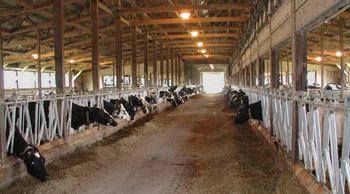

The U.S Dairy Forage Research Center Farm is located about 30 miles northwest of Madison on gently sloping acres bordering the Wisconsin River near Prairie du Sac, WI. The farm is an integral part of the research effort, allowing scientists to conduct a wide range of research scaled from large fields and the whole herd down to tiny field plots and individual cows.
UW Connection
The farm operates jointly with the University of Wisconsin–Madison College of Agricultural and Life Sciences, Agricultural Research Stations. The UW owns the dairy herd and uses revenues from the farm to offset operating costs and to pay the state employees who work at the farm. The dairy herd and research facility are also available for research by UW-Madison agricultural scientists.
Crops and Plots
Most of the 2,006 acres at the farm produce feed for the dairy herd. In turn, the fields are fertilized by manure from the dairy herd in a natural cycle. Large fields are also used to study cropping systems and manure management. Small research plots are used to grow lesser amounts of forages for use in various grazing, agronomic, and feeding experiments.
- 541 acres corn for grain and silage
- 340 acres alfalfa
- 310 acres soybeans
- 235 acres pasture
- 90 acres winter wheat
- 40 acres small research plots
- 450 acres woodlands
- Total = 2,006 acres


The Herd
There are about 350 lactating cows on the farm. Livestock housing includes both tie-stall and free-stall barns which serve different research needs and represent facilities being used in the industry. Cows are milked in a double-8 herringbone parlor with automatic take-offs and individual milk weights. Cows in free-stall barns are fed from a TMR (total mixed ration) wagon. In the tie-stall barns, several small TMR carts are used to mix and deliver research diets to selected cows. The farm raises all of its replacements. Newborn calves are housed in calf hutches and moved to a calf barn at eight weeks. At four-five months of age, heifers are moved to a free-stall barn where they remain until confirmed pregnant. Pregnant heifers are pastured in the summer and kept on a bedded pack in the winter.
- Current milk production
- 2× rolling herd average (as of April 2008)
- 25,033 lbs. milk
- 3.62% fat
- 3.00% protein


Research Efforts
At any given time there may be 15–25 different research projects being conducted at the farm. The research falls into four main categories:
- Understanding how dairy cows digest and utilize forages;
- improving forages so they are better used by dairy cows;
- improving methods of harvesting and storing forages;
- and studying the impact of dairy systems on the environment to help dairy farmers know the best ways to protect the environment and efficiently recycle the nutrients in manure—from crop to cow to manure and back to the crop.


Unique Heritage
Efforts to establish a USDA dairy research facility date back to the late 1950s. But it wasn't until the 1970s when planning began for this facility and Congress appropriated the funds. Construction of the farm facilities began in 1980; this same year the first animals were brought to the farm.
The land on which this farm is located has a rich and unique history. First inhabited by Native Americans, European settlers began turning it into farmland in the 1830s. Then, at the dawn of the U.S. entry into World War II, the Department of Defense confiscated the land from 80 farm families in order to build a munitions plant. Known as the Badger Army Ordinance and later the Badger Army Ammunition Plant (BAAP), the facility manufactured gun powder during World War II, the Korean War, and the Vietnam War. It was put on standby status in 1976.
When the USDA was looking for a site for this research farm, it obtained a special permit through the U.S. Department of Defense to farm about 1,500 acres of the 7,354-acre BAAP site for 20 years at no cost. In 1999 the USDA started making lease payments. And in September of 2004, the USDA received custody of 1,943 acres of the BAAP.


Related Documents
Take a virtual tour of the farm (PDF)
2005 Farm Report (PDF)
2005 Herd Report (PDF)
Staff
Richard P. Walgenbach
Research Agronomist and Farm Manager
richard.walgenbach@ars.usda.gov
Jim Meronek
Herd Manager
jmeronek@wisc.edu
Arrange a Tour
The farm is a popular stop for visitors from around the world throughout the year. Individuals or groups are welcome at any time and can arrange a tour by contacting the farm.
Address
U.S. Dairy Forage Research Farm
S8822 State Hwy. 78
Prairie du Sac, WI 53578
Local: (608) 643-2438
Federal: (608) 264-5138/9
Map/directions to farm (Google Maps)
























